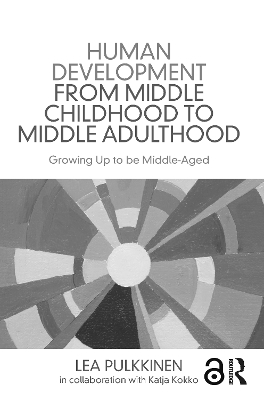
Human Development from Middle Childhood to Middle Adulthood
Routledge (Verlag)
978-1-138-84015-7 (ISBN)
This seminal work focuses on human development from middle childhood to middle adulthood, through analysis of the research findings of the groundbreaking Jyväskylä Longitudinal Study of Personality and Social Development (JYLS). The JYLS project, which began in 1968, has generated extensive publications over many years but this is the first comprehensive summary that presents the conceptual framework, the research design and methodology, and the findings. The study looks at the development over time of issues related to personality, identity, health, anti-social behavior, and well-being and is unparalleled in its duration, intensity, comprehensiveness and psychological richness.
The thorough synthesis of this study illustrates that there are different paths to adulthood and that human development cannot be described in average terms. The 42-year perspective that the JYLS provides shows the developmental consequences of children’s differences in socioemotional behavior over time, and the great significance of children’s positive socioemotional behavior for their further development until middle age.
Not only will the book be an invaluable tool for those considering research methods and analysis on large datasets, it is ideal reading for students on lifespan courses and researchers methodologically interested in longitudinal research.
Lea Pulkkinen, PhD, is Professor of Psychology Emerita at the University of Jyväskylä, Finland. For 40 years, she has conducted a longitudinal study on personality and social development. Her interest has focused on the continuity of positive and problem behaviors over time, and transformation of findings into policy for improving the quality of life in childhood and adulthood.
List of figures
List of tables
List of boxes
Preface
PART I: Introduction to the Jyväskylä Longitudinal Study of Personality and Social Development
Chapter 1: How the longitudinal study began
A historical context for the study of aggression
Positive behavior in an impulse control model and the goals of the study
The search for alternatives to aggression
The impulse control model
The goals of the longitudinal study
Research conditions in Finland and in the longitudinal study
Chapter 2: The execution of the longitudinal study
The research sample and the major waves of data collection
Attrition and the representativeness of the sample
Additional data collections
Assessment methods
Peer nomination and teacher rating
Personal interview
Self-reports and other methods
Data analysis
Chapter 3: Reflections on the research process
The evaluation of choices
Recommendations for launching a longitudinal study
What is development?
PART II: The development of personality and psychological functioning
Chapter 4: Theoretical frameworks for the study of socioemotional development
From cognitive control of impulses to self-control
Updated framework
The model for the Unfolding of Socioemotional Behavior
Self-regulation and executive functions
Towards cumulative theoretical reasoning
Three layers of personality for organizing research findings
Chapter 5: The person as social actor
Questions to be answered
Socioemotional behavior in childhood and adolescence
Agreement between informants
2 Continuity in socioemotional behavior
The person-situation controversy
Children grow and adult styles of life emerge
The two-dimensional framework across generations
The unfolding of the styles of life from age 8 to 27
The developmental background of the styles of life
A person-oriented approach to personal styles at age 27
Personality profiles at ages 33 to 50
Maturation, adjustment, or growth in adult personality
Childhood socioemotional behaviors as predictors of adult personality characteristics
Roots of the personality profiles and the clusters of personal styles
The roots of adult agreeableness and continuity in aggression
Paths from childhood socioemotional behavior to adult personality
Chapter 6: The person as motivated agent
The transition to adulthood
Age-stratified or individualistic transitions?
Life changes in early adulthood
Patterns and timing of adult transitions
The length and timing of one’s education
The structure of education
Predictors of the choice of education
"Off-time" education and other post-comprehesive educational trajectories
Goals and values
Common elements in the life structure of adults
Values in middle age
Individual life structures and unifying life themes
Chapter 7: The person as autobiographical author and an "experiencer" of life
A holistic approach to personality
Self-reflections
Identity formation
Personal control over one’s own life
Optimism and self-esteem
Turning points
A study of turning points
Individual differences in the experience of turning points
A qualitative analysis of turning points
Chapter 8: Personality and psychological functioning
Personality and well-being
The concept of mental well-being
Continuity in well-being
The personality traits associated with mental well-being
The model for personality and psychological functioning
Explanations for the associations between personality traits and psychological functioning
PART III: The development of social functioning
Chapter 9: Social development and social functioning
Conceptual approaches to social functioning
The spheres of life
Processes in social functioning
Chapter 10: Problems in social functioning
Antisocial development
Antisocial behavior
From aggression to antisocial behavior
Proactive and reactive aggression as predictors of criminal offending
Accumulation of problems
Multi-problem predictors of problem behaviors
Dynamic processes in the accumulation of problems
Continuity from risk factors to social functioning problems
Offender groups compared
Offender groups
Differences in personality
Social background
Life success of the offender groups in adulthood
Conclusions and suggestions for prevention
Chapter 11: Health behavior
Substance use
The start and continuity of the use of alcohol
Problem drinking in middle age
Socioemotional characteristics associated with drinking
Social backgrounds of the use of alcohol
Smoking cigarettes
Health risks
Health in early adulthood
The predictors of accidents and impairment
Subjective health and metabolic syndrome in middle age
Temperance in adulthood
Chapter 12: The family and its care functions
A partnership in the family
The structure of the family
The relationship between the partners
Adult attachment
Parenting
Delights and stresses in parenting
Parental identity
Child-rearing practices
Relationships in the chain of generations
Chapter 13: Work as a sphere of life
Occupational status and career line in women and men
Success in career path
Constructive behavior in childhood as the antecedent of success in the work domain
Satisfaction with work
Occupational well-being and personality
Job insecurity
Unemployment and psychological distress: selection or causation?
Health consequences of the unstable career line
The consequences of economic strain for the family and parenting
Work-family balance
A stress theory approach to work-family interface
A role enhancement theory approach to work-family interface
Successful reconciliation
Recovery from work and the content of free time
PART IV: Epilogue
Chapter 14: Navigating through the spheres of life
Middle age: a prime time
Midlife transition
The person functioning in the different spheres of life
Chapter 15: The integrated model for individual differences in social and psychological functioning
Chapter 16: A credo
References
Author index
Subject index
| Erscheinungsdatum | 30.06.2017 |
|---|---|
| Zusatzinfo | 18 Tables, black and white |
| Verlagsort | London |
| Sprache | englisch |
| Maße | 156 x 234 mm |
| Gewicht | 521 g |
| Themenwelt | Geisteswissenschaften ► Psychologie ► Entwicklungspsychologie |
| Geisteswissenschaften ► Psychologie ► Psychoanalyse / Tiefenpsychologie | |
| Pflege ► Studiengänge ► Pflegewissenschaft | |
| ISBN-10 | 1-138-84015-7 / 1138840157 |
| ISBN-13 | 978-1-138-84015-7 / 9781138840157 |
| Zustand | Neuware |
| Haben Sie eine Frage zum Produkt? |
aus dem Bereich


